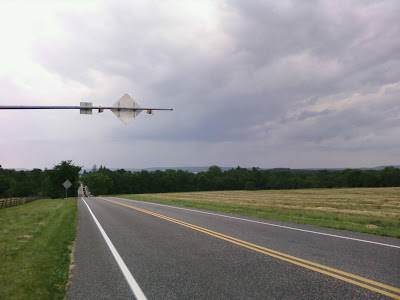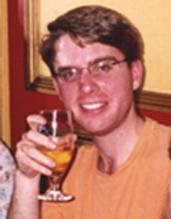Gettysburg is the jaw drop capital of the world.

Dad at the Cashtown Inn. Founded in 1797 and located west of town, it's now a restaurant and B&B. General Lee and the Johnnies stayed here on June 30, the night before the action started.

Taking a breather at the Appalachian Brewing Company, located right next to General Lee's headquarters.

Looking west on Chambersburg Road.

This is where the first melee of Gettysburg took place, between Union General Buford's cavalry scouts and Confederate General Hill's boys.

Dad with the Civil War photo book (which inspired this trip in the first place) in front of a statue of Union General Doubleday (the inventor of baseball) near where General Reynolds was killed.

Monument to the 95th New York regiment looking east into railroad cut.

Dad at the monument to the Iron Brigade.

North Carolina monument. One out of every four Confederates who fell at Gettysburg were from North Carolina.

Looking east from Seminary Ridge with the Pennsylvania memorial just visible on the right as that little white speck.

Me in front of the memorial to North Carolina. It was designed by the same architect who planned Mount Rushmore, Gutzon Borglum, a first generation Danish-American who was a Confederate sympathizer.

Dad and me in front of the North Carolina memorial.

Memorial to Virginia. The North Carolina memorial is behind me. This area is where Pickett's Charge started on the third and last day of battle.

Dad aiming a cannon with the Virginia memorial in the background.

That's me chillin' by one of the cannons near the Virginia memorial.

Dad's Mustang parked near the North Carolina and Virginia memorials.

Dad in front of General Longstreet statue.

Black Horse Tavern. It is no longer a tavern, much to my parched chagrin.

Up the road from the Black Horse Tavern. It's behind the trees on the right.

Reenactment sign just up the road from the Black Horse Tavern.

Dad in front of the monument to Union General Reynolds. Reynolds was the highest-ranking officer killed at Gettysburg.

Dad's Mustang parked near the General Reynolds monument.

Statue of a general on a horse near the Gettysburg cemetery. Not sure who. It may be Doubleday.

Another officer on a horse near the Gettysburg cemetery. Is it Doubleday?

Facing east from those horseback-riding officers above. The cemetery is behind me.

Evergreen Cemetery Gate.

Emmitsburg Road looking east as General Pickett might've seen it.

The Lincoln Diner! Where else would you have breakfast in Gettysburg? This is where Dad and me breakfasted on Thursday (day two).

Looking west from Cemetery Ridge at the Cordori house.

Facing Little Round Top to the east from the (in)famous peach orchard.

Facing south from Wheatfield Road.

The 'Stang parked near the peach orchard on Wheatfield Road.

You can't go to Gettysburg and not hang out at friggin' United States Avenue!

A house west of the road near the peach orchard. Can you imagine living here when one of the most significant battles in our country's history is happening right outside your windows?

Same house as above from the side.

An impressive memorial to a Rhode Island regiment.

Dad at a New York artillery monument on Cemetery Ridge.

Facing Little Round Top from the west. During the battle, Little Round Top became the Union's extreme left flank.

Monument to the Bucktails (officially the 13th Pennsylvania Reserves).

Dad and his 'Stang near the wheatfield.

Me in front of the very impressive monument to the original three regiments of the Irish Brigade (the 63rd, 69th, and 88th New York regiments). That's an Irish Wolfhound at the base of it.

This monument's for the 116th Pennsylvania regiment, added to the Irish Brigade just before Gettysburg, as the original three had gotten pretty beat up during the first two years of the war. Shit, who wasn't beat up at this point?

Boy Scouts from Jersey taking a pee break near Slaughter Pen. What a name, huh? Slaughter Pen.

Slaughter Pen with Devil's Den in the background. Devil's Den was already called Devil's Den by the time Gettysburg happened. The locals had been superstitious about it for decades. Slaughter Pen, on the other hand, earned its moniker during the battle when it became the site of a particularly brutal melee.

Devil's Den. You can just barely see me there in that nook. I was wearing a dark shirt which makes me all but invisible.

If you look closely, you can see me sort of posing on Devil's Den with my arm out. Dad and I were trying to reproduce this old photo from the 1860s where this one soldier was posing the same way I'm doing here.

Dad at the scene of perhaps the most famous photo from the battle. In the original photo, the body of a Confederate sniper was sprawled here. The photographer actually found the body out in the field behind me, and then positioned it here. The body had no ID, so the photographer was lamenting that some poor mother would never know what happened to her baby boy.

There's me at the same sniper spot.

A pair of reenactors hanging out on top of Devil's Den. Dad and I called them ghosts. On Friday, the day we left, the official three-day reenactment of the battle began. I'm not sure why they didn't do the reenactments on the same three days as the battle. I suppose the weekend was more convenient.

Dad at the monument to the 20th Maine regiment on Little Round Top. This regiment was the extreme left flank of the Union Army. Had they fallen to the boys from Alabama, Gettysburg, and by extension the entire war, may have turned out quite differently.

Facing Devil's Den from the top of Little Round Top.

Looking northwest from Little Round Top. These photos don't do it justice. The views really were great.

Facing west from the north end of Little Round Top.

Statue of Union General Warren on the north end of Little Round Top. When I took this photo, a couple in their thirties or forties from Florida was talking behind me. I'm assuming they're from Florida because they both wore Florida State University T-shirts. Anyway, the guy was really bitter about the battle at Little Round Top, which took place on the second day of Gettysburg. According to him, had the Rebs gotten to Little Round Top just ten minutes sooner, they would've won. Seriously, he was bitter. He was cussing and all that. Hilarious. Talk about needing to let go.

This is as far north on Little Round Top as you can get. Behind me there's a steep drop. This monument here honors the Union's second division.

Indiana monument near Spangler's Spring.

Dad standing at a monument to one of the Massachusetts regiments near Spangler's Spring, pointing toward the Indiana monument above. As with me and the Devil's Den photo, we were trying to reproduce an old photo, in this case from the 1880s when this monument was dedicated. This monument was the first ever at Gettysburg dedicated to a particular regiment. Today Gettysburg has tons of regimental monuments all over the place. I wonder what it's like to live in a town like that.

And here's Spangler's Spring itself. At the time of the battle, soldiers from both sides used it to get water. Which might explain why it's all dried up today. A lot of soldiers at Gettysburg, and they were all obviously parched.

There's that Mustang again! It gets around, doesn't it? That's the Indiana memorial behind it.

This is where President (formerly General) Dwight "Ike" Eisenhower retired in the 1960s. His family descended from German immigrants who settled near Gettysburg. He'd been in love with Gettysburg his whole life. Dad and I took a break from all the battlefield stuff so we could take the Eisenhower tour. You can catch the bus to this place from the Gettysburg visitor center. Among the rooms in there is the TV room where Ike liked to watch Gunsmoke and other serials. It's the same room where he drank beer and shot the shit with the likes of Nikita Khrushchev and Chiang Kai-shek. I'm not kidding.

The monument to Maryland which, unlike any other state, had some regiments fighting for the North while others fought for the South. That's messed up, man.

That's me chillin' out at a house that originally belonged to some poor widow. During the battle, Union General Meade, who was basically in charge of the entire Union side, used this house as his HQ. It didn't do him much good. On day three, during Pickett's Charge, the Rebs were firing cannonballs that landed here. Meade was lucky to get out of there alive.

Dad at Meade's HQ.

Me hanging out at the North Carolina monument at the site of Pickett's Charge.

Dad at the site where Confederate General Lew Armistead was shot and wounded (he died of his wounds two days later). Lew was well respected by his Northern counterparts. Union General Winfield Hancock was a close pal of his from their California days. Lew was by all accounts a decent guy. If you don't count the fact that he fought for the bad guys.

Dad in front of the (in)famous copse of trees, facing east across the field (behind me) where Pickett's Charge started. Pickett's goal was to reach this very copse. His men never made it. In fact, it was a complete bloody disaster, and I'm amazed Lee was stupid enough to think it would work. But I have hindsight, he didn't, so.

There's the Cordori house way out yonder.

Dad taking a stroll along the Pickett's Charge site. Charge!

While my dad hung out around the copse of trees and the other Pickett's Charge monuments, I high-tailed it over to this very impressive memorial to Pennsylvania. You can see this from quite a ways, and this was my only chance to check it out up close and personal.

Looking northwest from the top of the Pennsylvania memorial.

Now looking south.

This sign's at the top of the stairs inside the Pennsylvania memorial.

On my way back down the stairs I took this shot facing west over the top of Lincoln's head.

Facing west from the bottom of the stairs.

One more for the money. That's Lincoln on the left. You can see the windows where I snapped that one shot above.

This monument's right by the copse of trees. I think this one just honored the North in general, or those from the North who fought against Pickett's Charge.

Dad reading that giant tablet on the other side of the copse from where the Charge was repulsed.

And now we head into the Soldiers National Cemetery. It's depressing as hell, but you gotta do it, right?

Each grave had its own little flag. In the distance dead ahead you can see the Soldiers' National Monument.

More flags. A flagscape. Is that a word?

A mass grave for unidentified Ohioans.

In case you wanted to see more flags...

Did I mention it was depressing?

Ugh.

The Soldiers' National Monument at the center of the cemetery. This is where Lincoln gave the Gettysburg Address.
